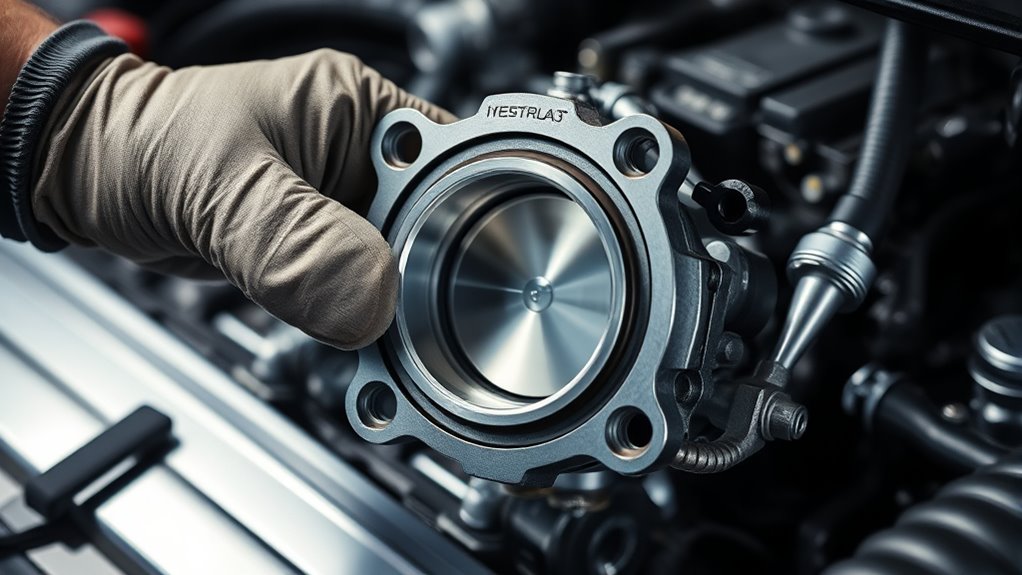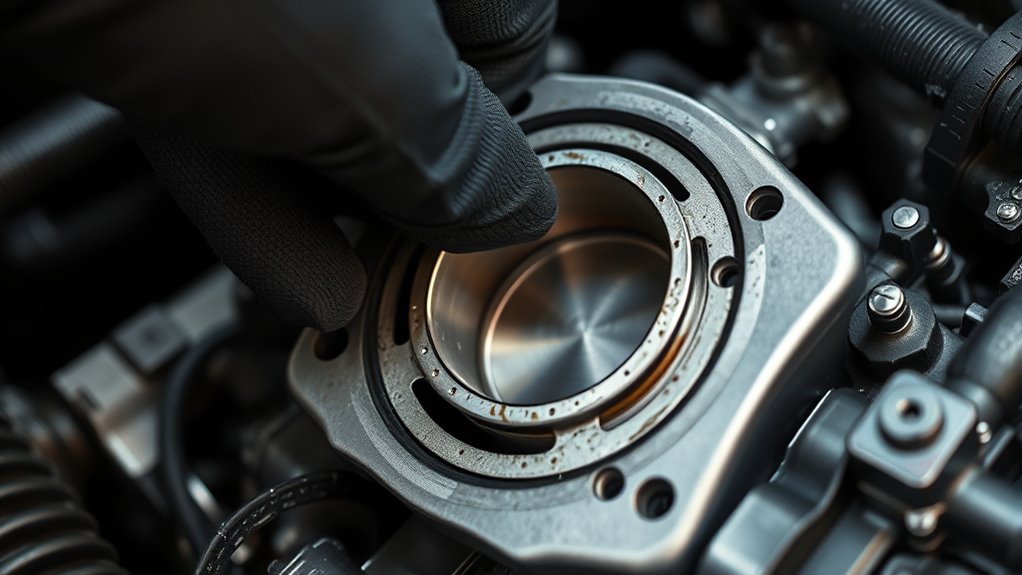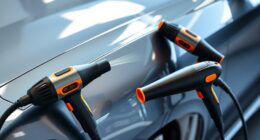To boost your car’s performance, start by locating the throttle body, usually connected to the air intake hose. Spray a throttle body cleaner onto the opening while gently opening the throttle plate, then wipe away carbon buildup with a soft cloth. If it’s heavily coated, consider removing it for a thorough clean. Regularly maintaining this component keeps airflow smooth and engine response sharp. Keep going to discover detailed steps for a safe and effective cleaning process.
Key Takeaways
- Locate the throttle body, typically connected to the air intake hose, before cleaning.
- Use throttle body cleaner and a soft cloth to spray and wipe away carbon buildup.
- Open the throttle plate gently while spraying cleaner to reach all deposits.
- Reassemble the throttle body securely and ensure electrical connections are intact.
- Start the engine, idle for a few minutes, and observe improved smoothness and performance.

Your car’s throttle body plays a crucial role in controlling airflow to the engine, but over time, dirt and carbon buildup can impair its function. When the throttle body gets clogged, you might notice your vehicle’s idle becomes rough or unstable. It may stumble or stall at stops, and your fuel efficiency could decline as the engine struggles to get the right amount of air needed for ideal combustion. Cleaning it can notably improve these issues, restoring smooth idling and saving you money at the pump.
Clogged throttle bodies cause rough idling, stalls, and poor fuel economy—cleaning restores smooth performance and efficiency.
The buildup inside the throttle body creates a barrier that disrupts airflow, which is essential for maintaining stable engine performance. When airflow isn’t properly regulated, your engine’s computer receives incorrect data, causing it to adjust fuel delivery improperly. This miscommunication can lead to uneven idling, hesitation during acceleration, or sudden surges. Cleaning the throttle body removes these deposits, allowing air to flow freely, which helps the engine maintain a steady idle and operate more efficiently.
To start, you’ll need a few basic tools: a throttle body cleaner, a soft cloth, and possibly a socket wrench if you need to remove the throttle body assembly. First, locate the throttle body, usually connected to the air intake hose. If you can access it without removing it, spray the cleaner directly onto the throttle plate while gently opening it with a screwdriver or your hand. Be careful not to damage any sensors or electrical connections. Wipe away the loosened carbon deposits with a clean cloth. If the throttle body is heavily coated, removing it from the intake system might be necessary for a thorough clean.
As you clean, pay special attention to the throttle plate and the surrounding bore, since these areas tend to gather the most grime. After cleaning, make sure everything is dry before reassembling. Once reconnected, start your engine and let it idle for a few minutes. You might notice the engine runs more smoothly and the idle stabilizes quickly. This process can also improve fuel efficiency because the engine no longer struggles to draw in air through a clogged throttle body.
Performing this maintenance periodically, especially if you notice rough idling or decreased fuel economy, keeps your engine running at peak performance. Regular cleaning prevents excessive buildup, reduces the strain on other engine components, and ensures your car responds predictably. In the long run, maintaining a clean throttle body enhances both idle stability and fuel efficiency, giving you a smoother, more economical driving experience.
Frequently Asked Questions
How Often Should I Clean My Throttle Body?
You should clean your throttle body every 30,000 to 50,000 miles, depending on your driving habits and air quality. Incorporate throttle cleaning frequency into your maintenance schedule to keep your engine running smoothly. If you notice rough idling, poor acceleration, or increased fuel consumption, it’s a sign you need to clean the throttle body sooner. Regular maintenance ensures peak performance and prevents buildup that can cause issues.
Can I Clean the Throttle Body Without Removing It?
You can clean your throttle body without removing it by using cleaning methods that involve a throttle body cleaner and a soft brush or cloth. While some might think removal is necessary, careful application of the cleaner through the intake hose works well and saves time. Just make certain you disconnect the air intake, spray the cleaner, and gently scrub to remove deposits, improving your engine’s efficiency without the hassle of throttle body removal.
What Tools Are Safest for Cleaning the Throttle Body?
You should use safe tools like soft cloths, soft-bristle brushes, and specialized cleaning solvents designed for throttle bodies. Always wear protective gloves to prevent skin contact with chemicals. Avoid harsh abrasives or metal tools that could damage the throttle body’s surface. Using the right cleaning solvents guarantees effective removal of grime without harming components, and gloves keep you safe from potential irritants or fumes during the cleaning process.
Will Cleaning Improve My Fuel Efficiency Immediately?
Yes, cleaning your throttle body can boost your fuel economy and reduce emissions right away. Imagine the engine breathing freely, with air flowing smoothly through a clean throttle plate. As dirt and carbon build-up clear, your car runs more efficiently, saving fuel and lowering emissions. You’ll likely notice smoother acceleration and a more responsive drive, making every mile more economical and eco-friendly immediately after the cleaning.
Are There Signs Indicating My Throttle Body Needs Cleaning?
Yes, there are signs your throttle body needs cleaning. If you notice idle issues like rough or uneven idling, or experience acceleration problems such as hesitation or sluggish response, these could indicate buildup or dirt. Cleaning the throttle body can help restore smooth airflow, improve engine response, and fix these issues. Pay attention to your car’s performance; addressing these signs promptly can prevent further engine problems.
Conclusion
Cleaning your car’s throttle body improves performance, boosts fuel efficiency, and extends engine life. It’s a simple task that saves you money, enhances driving experience, and gives you peace of mind. When you keep the throttle body clean, you improve acceleration, prevent stalling, and enjoy smoother rides. So, take the time to do it yourself, stay proactive, and keep your engine running like new. Because a clean throttle body equals a happier, healthier car.









